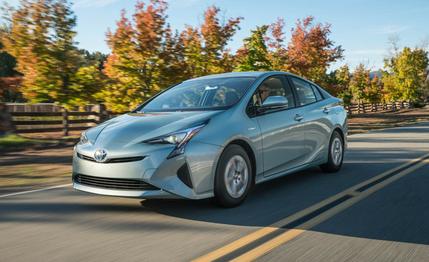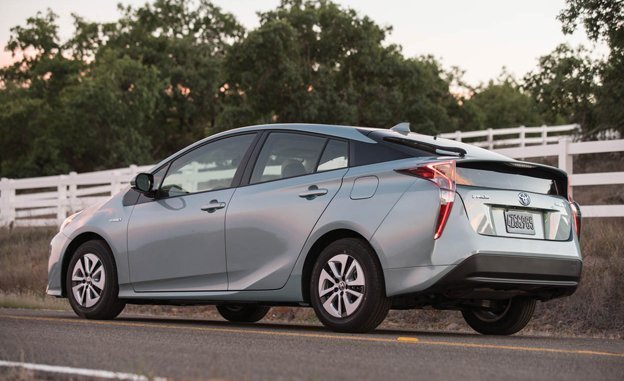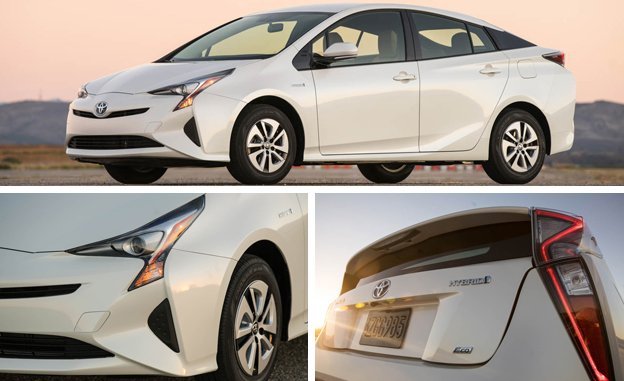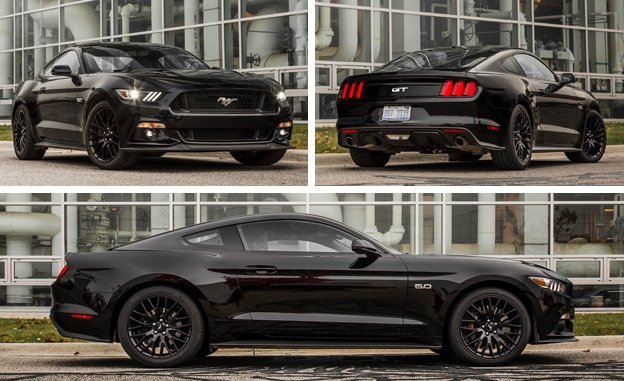 First Drive Review
First Drive Review
Hybrid cars in general, and the Toyota Prius in particular, have become so much a part of the fabric of the automotive scene that it’s easy to forget that the original Prius went on sale in Japan less than 20 years ago. And it didn’t come to America until 2000.
Yet since 1997, Toyota has hawked more than 5 million Prii of various descriptions around the world. As such a mainstream model, it gets regular updates every six years, so we’re here to give you the lowdown on the 2016 version.

Like so many traditional sedans of yesteryear, the new Prius is longer, lower, and wider. The length increase is 2.3 inches while the other two change by only 0.6 inch, but the net effect is to give the ’16 Prius a sleeker and slightly more athletic stance. While the overall profile retains the wedgy teardrop look that began with the 2004, second-generation Prius, the body panels have a few more creases and bulges to provide more visual interest. LED headlights and taillights are both smaller and more distinctive than the current model’s, and the hoodline dips markedly lower.
This closer-to-the-pavement impression is more than cosmetic, because the new model has a one-inch-lower center of gravity, thanks to the new TNGA (Toyota New Global Architecture) platform, which uses more high-strength steel and provides 60 percent greater torsional rigidity. With this platform, the Prius also gets a multilink rear suspension, which is heavier than the previous torsion beam but provides more favorable suspension geometry, for better handling. This heavier suspension, along with the relocation of the hybrid battery from the trunk area to below the rear seat, probably accounts for most of the center-of-gravity reduction.
Passenger volume is fractionally smaller than before, but trunk space has grown from 22 to 25 cubic feet—and even more in some versions. Inside, the new Prius retains the traditional central instrument cluster, but the dashboard now sweeps into the doors gracefully and has a very prominent central display with clearly separated HVAC controls. However, the top of the dashboard is still hard plastic with a softish coating.

Of course, with a Prius, the emphasis is always on efficiency, achieved with its high-tech powertrain. This new model employs an upgraded version of the outgoing car’s Atkinson-cycle engine, with the addition of a cooled exhaust-gas-recirculation system, and faster combustion due to intake ports that increase tumble in the combustion chambers. According to Kentarou Tomo, a Grand Master—yes, that’s really one of his titles—in the Hybrid Engineering Department, the new engine achieves a diesel-like peak thermal efficiency of 40 percent. Power is down from 98 to 95 horsepower, while the torque peak of 105 lb-ft is maintained, but developed slightly lower at 3600 rpm.
On the electrical side, the motor has been downsized slightly, cutting its output from 80 to 71 horsepower and its torque from 153 to 120 lb-ft. But it’s also physically smaller and lighter, and the engine’s output is limited by the power that the battery can deliver, so there’s no effective loss of power. In addition, the power-control electronics are more efficient thanks to a more effective cooling layout. And the transaxle has received a major redesign, replacing one of its two planetary gearsets with conventional helical gearing to reduce the number of gears in mesh and to reduce frictional losses by 20 percent.
Total system output is rated at 121 horsepower, but that’s using a new method of measurement that’s not consistent with the previous model’s rating of 134 horsepower. Tomo said that power is probably down slightly but that performance is expected to remain the same due to the improved low-end torque. Top speed is again governed at 112 mph.

Of course, the big number here is fuel economy, and while the official figures are not yet out, Toyota is projecting that the ratings will come in at 54 mpg city and 50 on the highway, increases of 3 mpg (city) and 2 mpg (highway) over the current car. With weight essentially unchanged and only a small aerodynamic improvement—the drag coefficient drops from 0.25 to 0.24—this is a useful improvement. But wait, there’s more.
Toyota is also introducing a Prius Eco model that is expected to achieve substantially better mileage—try 58 mpg city and 53 highway. To achieve these results, the Eco model, more properly called the Prius Two Eco, starts with the base Prius Two model and cuts 65 pounds via various measures. A lithium-ion battery instead of the nickel-metal-hydride battery shaves 35 pounds. The rest comes from eliminating the rear wiper and from replacing the space-saver spare tire—and its attendant jack—with a tire-repair and inflator kit.